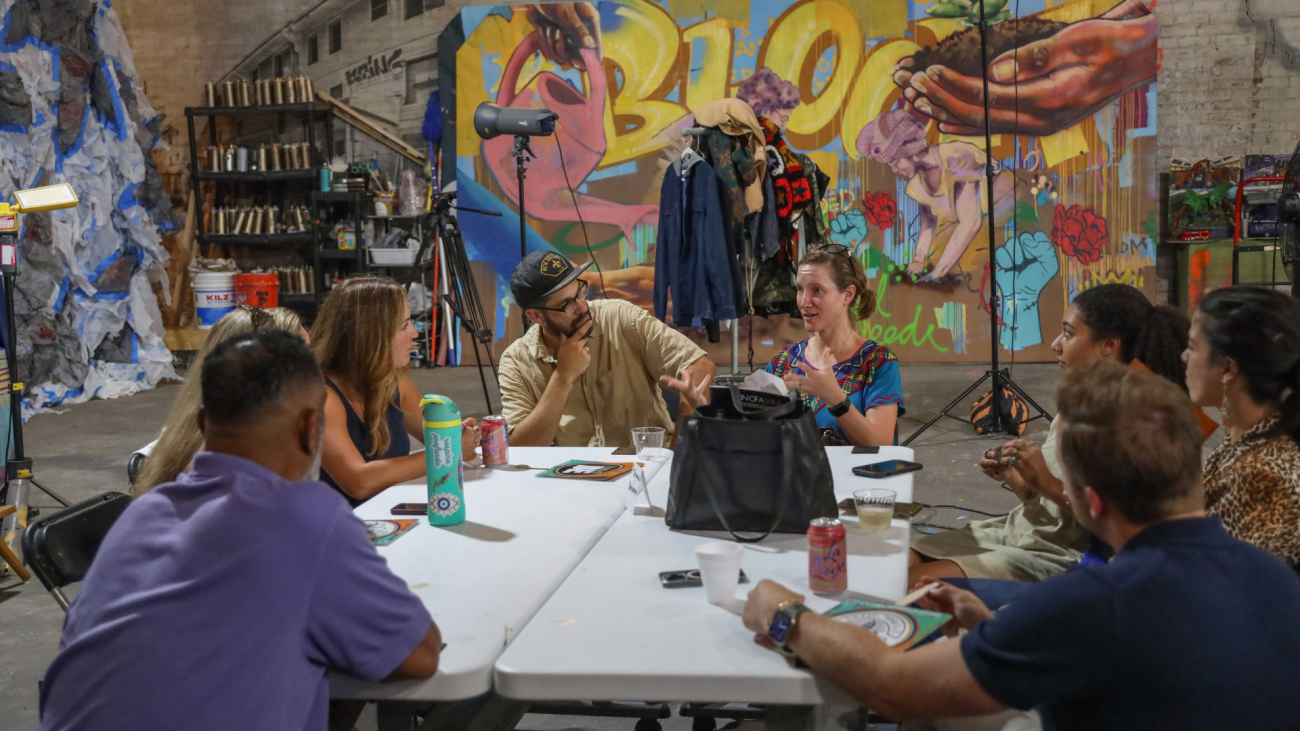
Artspace Immersion: New Orleans cohort participants during our mid-program visit.
Partnerships are like all relationships. At their core, they are simply people coming together with the shared belief that they can do more together than they can alone. On the Artspace Consulting team, my time working with arts groups, cities, and foundations as they come together on shared space-related goals has given me a front-row seat on all kinds of partnerships. A municipality interested in partnering with Artspace on an affordable housing project. A nonprofit client, developing a multi-tenant center. A pair of organizations participating in Artspace Immersion—our capacity-building program—as they co-create a new home. I have seen strong partnerships maximize impact and stabilize operations when groups weave their paths together. And I’ve also seen partnerships consume a dizzying amount of time, emotional energy, and resources as the fibers start to fray.
Good partnerships are based on a common goal, but great partnerships are based on a shared path of equality, understanding, and values.
In practice, collective goals bring partners into alignment, and divergent values can drive them apart. So how do we increase the chances of creating great partnerships? Though there’s no checklist for success, there are certainly ways to increase the chances.
To pave the way for more successful partnerships, we developed a process called Setting the Stage for Strong Partnerships. Through a series of assessments and discussion prompts, the process helps groups enter partnerships with open eyes, clear communication, and effective documentation.
It’s divided into three steps.
It all starts with READINESS, before any serious conversations with potential partners. This self-assessment encourages groups to look internally and clarify what they need and what they can offer.
The next step, UNDERSTANDING, begins when a potential partner has been identified. During this step, both groups explore whether this partnership is a good match at this time. The Setting the Stage for Strong Partnerships process offers a series of exercises and discussions to name the benefits of partnering, build trust with each other, recognize differences, and anticipate pitfalls.
The final step is MECHANICS. This happens after groups have decided they want to move down the path together. The partners-to-be spend time discussing how they will work together and clarifying the procedure. The key outcome of this step is a document that outlines the parameters and expectations of the partnership.
And in between these three steps are two DECISION POINTS. This is a moment for all parties to pause and choose between three options: to GO forward, NO-GO to exit the process, or DO OVER to spend more time exploring before forging ahead.
Setting the Stage for Partnerships was designed to mitigate the pressure and assumptions that can haunt partnerships down the line. When Artspace Consulting leads the process, we emphasize the importance of this intentionality and transparency not just at the beginning, but all the way through the partnerships. And when organizations complete the process they often comment on how helpful it was to have a framework to guide them through vulnerable conversations that would have otherwise been glossed over.
Partnership facilitation has been a feature of Artspace Immersion and other one-on-one consulting work for years, but this October we had the opportunity to take it to an even larger audience. Wendy Holmes and I presented this framework as a 90-minute workshop at the Social Enterprise Real Estate Summit in Detroit, hosted by the Nonprofit Centers Network. After sharing the process, we invited the participants—which included representatives from municipalities, community developers, foundations, and nonprofits—to role-play in small groups. They practiced the method to gain confidence in asking and answering big questions in a hypothetical situation. After the exercises, we facilitated group conversations to build a community understanding of the highs and lows of partnership experiences.
By the end of the workshop, the hypothetical partners had found new levels of trust and understanding. One participant noted the change in the body language of their round table—from reclined, arms-folded positions to forward-leaning, elbows-on-the-table, animated postures.
During the debrief, we discussed how Setting the Stage for Strong Partnerships could be applied to their own work. Some participants were on the brink of a new partnership and others had recently stepped into new positions with inherited partnerships. Several participants shared their new confidence in approaching their ‘real’ partnership conversations with a new structure.
We all laughed when someone shared that they were planning on applying it to their romantic partnership. Chuckles aside, it makes sense. Partnerships are like all relationships. And we all benefit when we walk with our partners down a shared path of equality, understanding, and values.
